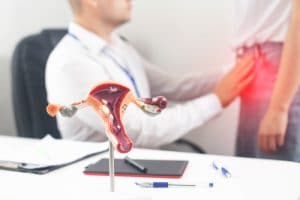It is estimated that endometriosis affects about one in 10 women of reproductive age. For some, the condition can be debilitating and yet for others, minor and complex symptoms of endometriosis can go undiagnosed by doctors.
Remarkably different from normal menstrual cramps, for women with endometriosis, severe pain can be a normal symptom. Along with monitoring symptoms of the condition, it’s important to understand more about endometriosis, especially if you believe you have it, to properly seek out the best solutions for treatments and symptom relief.
A Brief Look at Endometriosis
Endometriosis is a gynecological disorder that causes the endometrial tissue to grow outside of the uterus, as oppose to remaining in the lining of the uterus. With endometriosis, the uterine lining can also appear on other reproductive organs and even additional parts of the body, in these cases, endometrial tissue can grow on the ovaries, fallopian tubes, pelvic tissue and even the bowel. While this condition can be treated, it can lead to fertility struggles and even permanent infertility.
How is an Endometriosis Diagnosis Missed?
Currently, endometriosis is diagnosed via evaluation of symptoms and additional testing beyond an ultrasound, as these tests often don’t provide enough information to make a confirmed endometriosis diagnosis.
Additional diagnostic testing can include a pelvic exam, MRI scan, or laparoscopy. Unfortunately for some women, the road to an endometriosis diagnosis can be a lengthy process involving several misdiagnoses along the way.
What Are the Most Common Symptoms of Endometriosis?

- Mild to severe lower abdominal pain
- Severe menstrual cramps
- Heavy menstrual flow
- Pain during sexual intercourse
- Spotting between periods
- Gastrointestinal issues such as diarrhea or nausea
- Difficulty urinating or having a bowel movement during periods
- Infertility
While these symptoms, in addition to the physical composition and placement of endometrial tissue may seem obvious, for some, the condition goes unknown, leading to severe symptom pain and even infertility or recurrent miscarriages. So how is something, potentially so severe, left undiagnosed? A number of factors can be the culprit.
How is an Endometriosis Diagnosis Missed?
The most common cause of an undiagnosed endometriosis condition is a result of lack of symptoms. For women who show no discomfort or abnormal cycle changes, the absence of condition side effects leads to no cause for concern. When physical symptoms and discomfort aren’t a concern an undiagnosed condition can seem relatively harmless, however for those experiencing minor to severe symptoms, a missed diagnosis can contribute to ongoing pain and discomfort even beyond childbearing years. In addition, a missed endometriosis diagnosis can affect fertility and conception, and can even increase women’s risk of other health problems, not to mention the mental toll that comes from enduring chronic pain.
Similar to other gynecological conditions, such as polycystic ovarian syndrome (PCOS), there is lack of, and slow pace of research into this condition, which ultimately contributes to a lag in diagnosis. In fact, it has only been until recently that specialists around the world began really digging into the details of studying endometriosis. Without in-depth and continued research, women with endometriosis were left to manage their condition with minimal guidance and information to help lead their doctors.
In addition to a slow pace of research on the topic, many of the symptoms can present as vague indicators or very similar to symptoms of other conditions such as PCOS, pelvic inflammatory disease (PID), ovarian cysts, and even irritable bowel syndrome, ultimately leading to a misdiagnosis of a different medical condition with similar symptoms.
According to professionals from Baylor University Medical Center and Yale Medicine, it can take an average of 10 years for women to be properly diagnosed with endometriosis. Sadly, waiting for the proper diagnosis can have serious ramifications and the diagnosis process can feel overwhelming and defeating.
Regardless of the history of the diagnosis process, women who suspect they may have endometriosis can get a head start on the diagnosis process to aid their doctors in a swift diagnosis.
How to Speed Up the Diagnosis Process

1. Understand a basic endometriosis assessment. Have the answers to basic evaluation questions regarding endometriosis and have them ready to share with your doctor. Answers to have ready to go should include:
- Do you have severe menstrual cramps?
- Do you have excessive bleeding during menstruation?
- Do you experience regular pelvic pain that worsens during menstruation or ovulation?
- Do you experience pain before, during or after intercourse?
- Do you have painful bowel movements or urination?
- Do you have bleeding or spotting between periods?
- Do you experience fatigue, diarrhea, constipation, bloating, nausea, (especially during menstruation)?
- Are you experiencing struggles trying to conceive?
2. Track your symptoms in detail. It may be a daunting task, but keeping track of your symptoms with detailed accounts of symptoms’ description, length of time experienced, time during cycle experienced, and the severity of symptoms on a scale of one to 10 can help track patterns and irregularities that can aid in a more accurate diagnosis.
3. Find a specialist who deals with endometriosis. There are a slew of OB-GYNs and GYNs to choose from. If you are already seeing a gynecologist, fertility specialist or general doctor, ask to be referred to a gynecologist who specializes in endometriosis to ensure you are being evaluated by someone who is familiar with the condition and the accompanying symptoms.
For some women, the path to an accurate endometriosis diagnosis can be drawn out and frustrating. If you think you might have endometriosis, begin by keeping a detailed log of your symptoms to show your doctor and seek help with a professional.
If you have already taken these steps and feel as though your current doctor is minimizing your symptoms or negating your concerns, don’t feel uncomfortable about asking for a referral to a specialist or seeking a specialist or support group on your own to put your mind at ease that your health concerns be properly addressed.
Conclusion
Between self-advocating for your symptom diagnosis, and endometriosis research increasing over time, researchers and doctors can feel hopeful to find greater and more efficient ways to diagnose endometriosis accurately and timely, and ultimately treat the condition and its symptoms.





